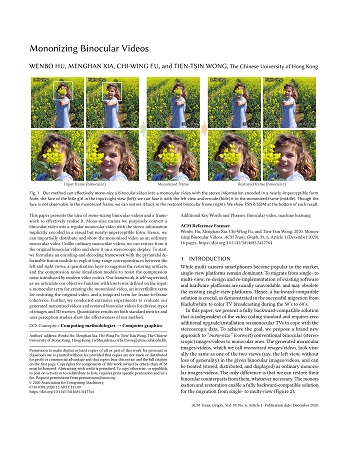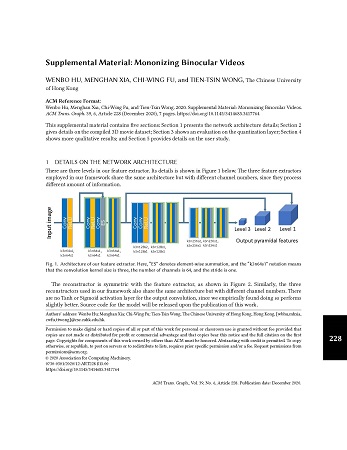| SIGGRAPHASIA2020 | |
|
Mononizing Binocular Videos |
|
|
ACM Transactions on Graphics (SIGGRAPH Asia 2020 issue), Vol. 39, No. 6, December 2020, pp. 228:1-228:16. |
|
|
|
|
Abstract This paper presents the idea of mono-nizing binocular videos and a framework to effectively realize it. Mono-nize means we purposely convert a binocular video into a regular monocular video with the stereo information implicitly encoded in a visual but nearly-imperceptible form. Hence, we can impartially distribute and show the mononized video as an ordinary monocular video. Unlike ordinary monocular videos, we can restore from it the original binocular video and show it on a stereoscopic display. To start, we formulate an encoding-and-decoding framework with the pyramidal deformable fusion module to exploit long-range correspondences between the left and right views, a quantization layer to suppress the restoring artifacts, and the compression noise simulation module to resist the compression noise introduced by modern video codecs. Our framework is self-supervised, as we articulate our objective function with loss terms defined on the input: a monocular term for creating the mononized video, an invertibility term for restoring the original video, and a temporal term for frame-to-frame coherence. Further, we conducted extensive experiments to evaluate our generated mononized videos and restored binocular videos for diverse types of images and 3D movies. Quantitative results on both standard metrics and user perception studies show the effectiveness of our method. |
Paper (PDF, 26.8MB) |
|||
|
Supplementary Material (PDF, 36.0MB) |
||||
|
Source Code |
|
Video
|
|
|
BibTex:
|



